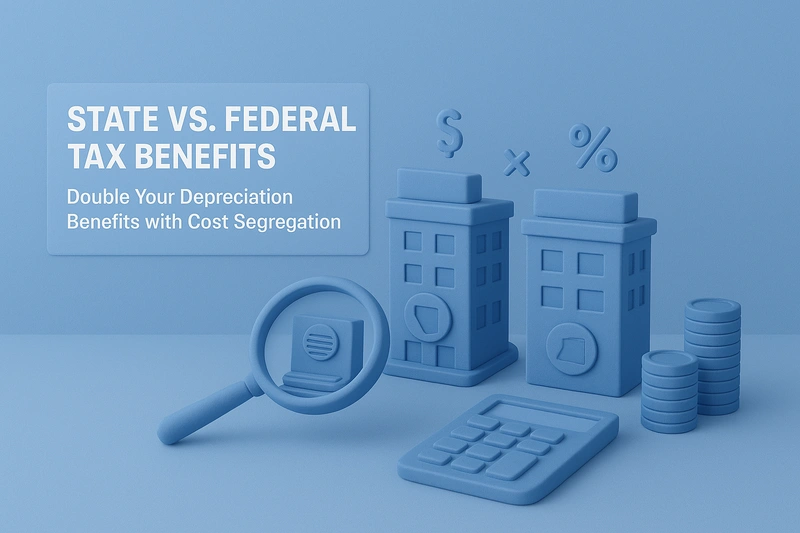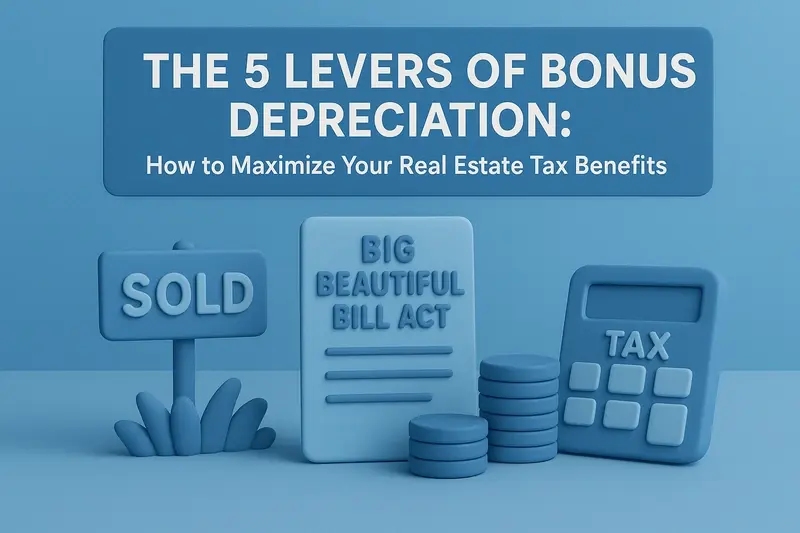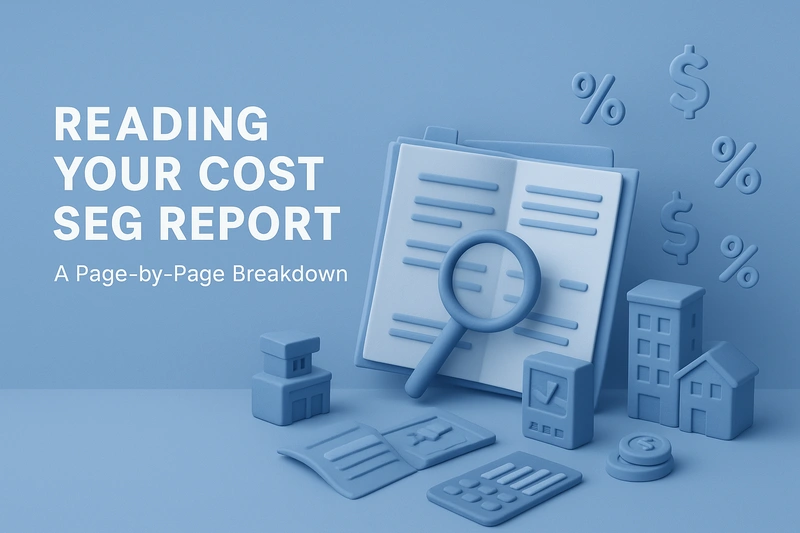Most real estate investors understand federal tax savings from cost segregation. What they miss is the state-level multiplier effect that can increase returns by an additional 15% to 30%.
This overlooked opportunity becomes even more powerful with the Big Beautiful Bill's restoration of permanent 100% bonus depreciation as of January 20, 2025.
The timing couldn't be better. While federal cost segregation services have become standard practice for sophisticated investors, the state tax benefits remain largely untapped.
R.E. Cost Seg analysis shows that investors in certain states can capture depreciation deductions twice, once at the federal level and again through strategic state tax planning.
Consider this: A $2 million commercial property typically yields $600,000 in first-year federal deductions through cost segregation. In states with favorable tax structures, that same study can generate an additional $50,000 to $100,000 in state tax savings.
This double benefit strategy works because states handle depreciation differently. Some conform to federal rules. Others don't.
The gaps between federal and state tax codes create legitimate opportunities for investors who understand how to navigate both systems simultaneously. Here's how to capture both benefits.
Understanding the Federal Foundation
Cost segregation reclassifies building components from real property to personal property for tax purposes. The distinction matters. Real property (Section 1250) depreciates over 27.5 years for residential or 39 years for commercial properties using straight-line depreciation.
Personal property (Section 1245) qualifies for 5, 7, or 15-year recovery periods with accelerated depreciation methods.
A proper cost segregation study identifies 20% to 40% of a building's components as personal property. These include specialized electrical systems, decorative fixtures, parking lot improvements, and landscaping. Each reclassified component accelerates depreciation deductions, creating immediate tax savings.
The 100% Bonus Depreciation Revival
The Big Beautiful Bill made 100% bonus depreciation permanent starting January 20, 2025. This eliminates the phase-down that would have reduced bonus depreciation to 40% in 2025. Qualified property now receives full first-year expensing indefinitely.
To qualify, property must meet specific requirements. Original use must commence with the taxpayer (with exceptions for certain used property). The property must have a recovery period of 20 years or less, including computer software, water utility property, or qualified improvement property. Most components identified in R.E. Cost Seg studies meet these criteria.
Federal Tax Savings Example
Take a $2 million commercial property with $100,000 in land value. Without cost segregation, annual depreciation equals $48,718 ($1.9 million divided by 39 years).
With cost segregation, identifying 30% as personal property:
- Personal property: $570,000 (100% bonus depreciation)
- Remaining building: $1,330,000 (39-year depreciation)
- First-year total deduction: $604,103
- Federal tax savings at 37%: $223,518
- Cash flow improvement: $174,800 over standard depreciation
These federal benefits form the foundation. State benefits multiply the opportunity.
Does My State Follow Federal Depreciation Rules?
The answer determines your double benefit opportunity. States fall into three categories based on how they treat federal tax code changes.
Twenty-four states fully conform to federal depreciation rules. These states automatically adopt federal cost segregation benefits, including 100% bonus depreciation. Another eighteen states selectively conform, choosing which federal provisions to follow. Eight states and the District of Columbia maintain independent depreciation systems.
This patchwork creates planning opportunities. Non-conforming states require separate depreciation calculations, allowing investors to maximize deductions under both systems. Even conforming states offer unique benefits through timing differences and state-specific incentives.
Three Categories of State Benefits
Full Conformity States
States like Florida, Texas, and Nevada mirror federal depreciation exactly. Your R.E. Cost Seg study automatically flows through to state returns. A $600,000 federal deduction becomes a $600,000 state deduction. Simple compliance. Immediate benefits.
These states update their tax codes automatically when federal laws change. The Big Beautiful Bill's permanent 100% bonus depreciation applies immediately without additional state legislation.
Partial Conformity States
California, New York, and Illinois conform selectively. California allows cost segregation but limits bonus depreciation. New York requires depreciation adjustments through Form IT-399. Illinois decouples from bonus depreciation entirely but permits accelerated MACRS depreciation.
These states create timing opportunities. Federal deductions hit immediately. State benefits are spread over multiple years. The mismatch reduces current state taxes while preserving future deductions. Smart investors use Form 3115 to optimize timing differences between federal and state recovery periods.
Non-Conforming States
States like Pennsylvania and New Hampshire maintain independent depreciation systems. This separation creates true double depreciation opportunities. Your federal cost segregation study establishes one set of deductions. State rules create another.
Example: New Hampshire allows 5-year straight-line depreciation for equipment that receives immediate federal expensing. You claim 100% federally and 20% annually at the state level. No recapture issues. No compliance problems. Just additional deductions following state law.
State-Specific Incentive Stacking
Beyond depreciation, states offer targeted incentives that compound cost segregation benefits. Enterprise zones provide additional depreciation allowances. Property tax abatements reduce carrying costs on reclassified personal property. Some states exempt personal property from property tax entirely.
State investment tax credits often apply to personal property identified in cost segregation studies. Historic rehabilitation credits stack with federal benefits. Energy efficiency incentives increase when applied to segregated building systems. Each incentive multiplies the value of your initial site visit and engineering analysis.
Maximizing the Double Benefit Strategy
Case Study: Multi-State Portfolio Optimization
An investor owns three similar $2 million retail properties in Texas (conforming), California (partial), and Pennsylvania (non-conforming). Each property has $1.9 million in depreciable basis. R.E. Cost Seg identifies $570,000 in personal property for each location.
Texas Property:
- Federal benefit: $570,000 immediate deduction
- State benefit: $570,000 (full conformity)
- Combined first-year tax savings: $233,700
California Property:
- Federal benefit: $570,000 immediate deduction
- State benefit: $81,429 (standard MACRS, no bonus)
- California tax savings: $10,504
- Total first-year savings: $221,404
Pennsylvania Property:
- Federal benefit: $570,000 immediate deduction
- State benefit: $114,000 (20% state depreciation)
- Pennsylvania tax savings: $11,082
- Total first-year savings: $221,982
The portfolio generates $676,086 in first-year tax savings. Without state planning, savings would total $631,500. The 7% increase represents $44,586 in additional cash flow from understanding state rules.
When Should I Conduct a Cost Segregation Study for Maximum State and Federal Benefits?
Year one maximizes federal benefits through 100% bonus depreciation. But state considerations might shift this timing.
In partial conformity states, conducting studies in high-income years optimizes state tax brackets. Some investors defer studies to years when state rates increase or before state conformity changes. Others accelerate studies before states decouple from federal bonus depreciation.
Look-back studies using Form 3115 offer flexibility. You can claim missed federal depreciation from prior years while timing state amendments strategically. State statutes of limitations vary from three to six years, creating different windows for amended returns.
The Depreciation Recapture Arbitrage
Federal recapture rules treat accelerated depreciation as ordinary income upon sale. State recapture often differs. Some states have no recapture provisions. Others apply lower rates to depreciation recapture than ordinary income.
This creates permanent tax benefits. Federal deductions save 37%. State deductions save 5% to 13%. Upon sale, federal recapture costs 37%. State recapture might cost nothing. The rate differential becomes permanent savings, not just timing differences.
Special Situations Creating Extra Benefits
Real Estate Professional Status unlocks additional state benefits. Passive loss limitations don't apply, allowing full depreciation deductions against other income. Some states recognize this status differently than federal rules, creating planning opportunities.
Pass-through entity taxes in states like Connecticut and New Jersey allow entity-level state tax payments. These payments become federal deductions, effectively making state taxes deductible again despite SALT limitations.
State net operating losses carry forward differently than federal NOLs. Strategic cost segregation timing can create state NOLs that offset future income when state rates rise.
Implementation Roadmap
Pre-Study State Analysis Checklist
How do I know if my state offers double benefits?
Start with this five-point assessment before engaging cost segregation services:
First, determine state conformity status. Check your state's current IRC conformity date. States conforming to IRC sections as of specific dates may exclude recent federal changes. This impacts bonus depreciation eligibility.
Second, review state depreciation schedules. Some states mandate different recovery periods or methods. Document these variations for accurate projections.
Third, identify available credits. Manufacturing equipment credits, research facility incentives, and energy efficiency programs often apply to segregated assets.
Fourth, analyze tax rates and brackets. Higher state rates increase cost segregation value. Progressive brackets create timing opportunities.
Fifth, consider multi-state requirements. Properties near state borders or businesses filing in multiple states need coordinated strategies.
Documentation Requirements
Federal studies require engineering-based analysis. State requirements vary. Some accept federal studies directly. Others demand state-specific documentation. California requires detailed workpapers. New York mandates specific allocation methods.
Maintain dual depreciation schedules from day one. Tracking federal and state basis separately prevents compliance issues.
Professional Team Assembly
Successful implementation requires coordination. Your cost segregation specialist must understand state variations. Your CPA needs experience with multi-state depreciation. State tax advisors should review studies before filing. This coordination prevents costly amendments and audit exposure.
Common Pitfalls and Solutions
Will Aggressive Cost Segregation Trigger a State Audit?
Not if documented properly. States audit cost segregation less frequently than the IRS. But when they do, they focus on specific issues.
State auditors question property classifications that differ from federal returns. Inconsistent treatment raises flags. If you claim 30% personal property federally but 40% for state purposes, expect scrutiny. Solution: Use identical classifications with different depreciation methods.
Documentation quality matters more for state audits. States have fewer resources than the IRS. They rely heavily on taxpayer records. Detailed engineering reports and clear site visit documentation typically satisfy state auditors. R.E. Cost Seg studies include state-specific documentation standards.
Compliance Complexity Management
Managing dual depreciation schedules challenges even experienced tax professionals. Fixed asset software must track federal and state differences. Manual spreadsheets invite errors.
Quarterly reviews catch problems early. State conformity changes mid-year. New legislation affects current returns. Regular monitoring prevents year-end surprises.
State filing deadlines differ. Federal extensions don't always extend state deadlines. Missing state deadlines forfeits depreciation deductions permanently in some jurisdictions.
Looking Ahead: Future Opportunities
States are responding to permanent 100% bonus depreciation. Illinois considers reconforming after years of decoupling. California debates expanding depreciation allowances for affordable housing. New York explores targeted depreciation incentives for upstate development.
Property tax reform accelerates nationwide. States recognizing personal property classifications from cost segregation studies for property tax purposes create additional savings beyond income tax benefits.
Action Items for 2025
With the Big Beautiful Bill now law, immediate action captures maximum benefits. Properties placed in service after January 20, 2025, qualify for permanent 100% bonus depreciation. Existing properties benefit from look-back studies using Form 3115.
Schedule site visits before state legislative sessions potentially change conformity rules. Lock in current benefits while planning for future opportunities.
The Double Benefit Bottom Line
State and federal cost segregation creates compound returns through strategic depreciation planning. Permanent 100% bonus depreciation multiplies these opportunities.
Every property deserves analysis for both federal and state benefits.
Calculate Your Double Benefit: Request your free proposal with R.E. Cost Seg. Discover your property's hidden tax savings across all jurisdictions.
With permanent bonus depreciation now available, waiting costs money. Start your analysis today.






